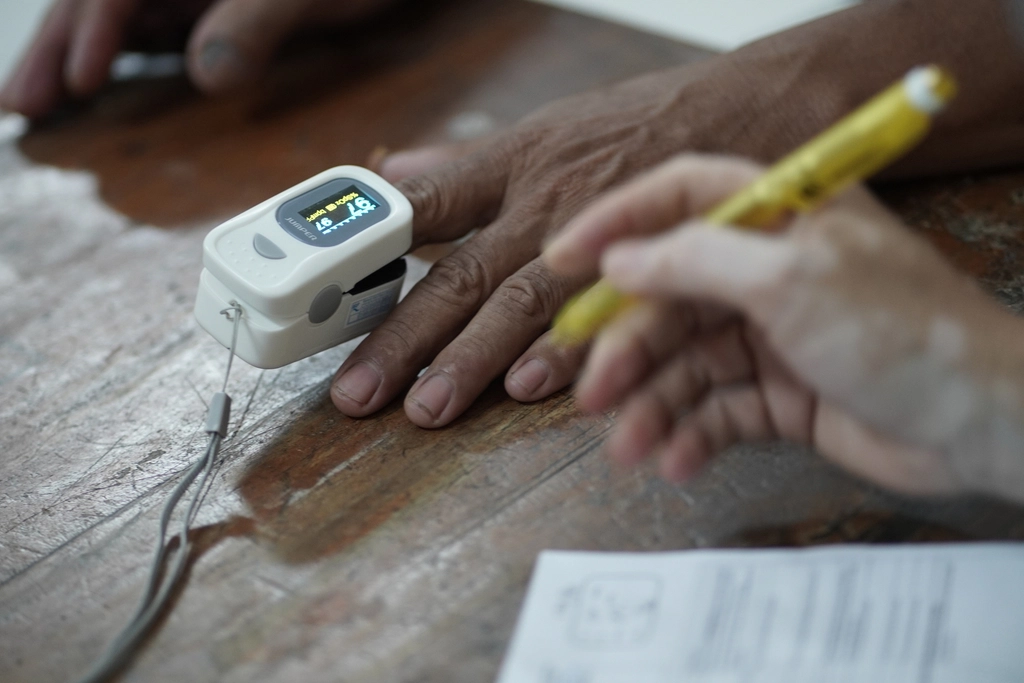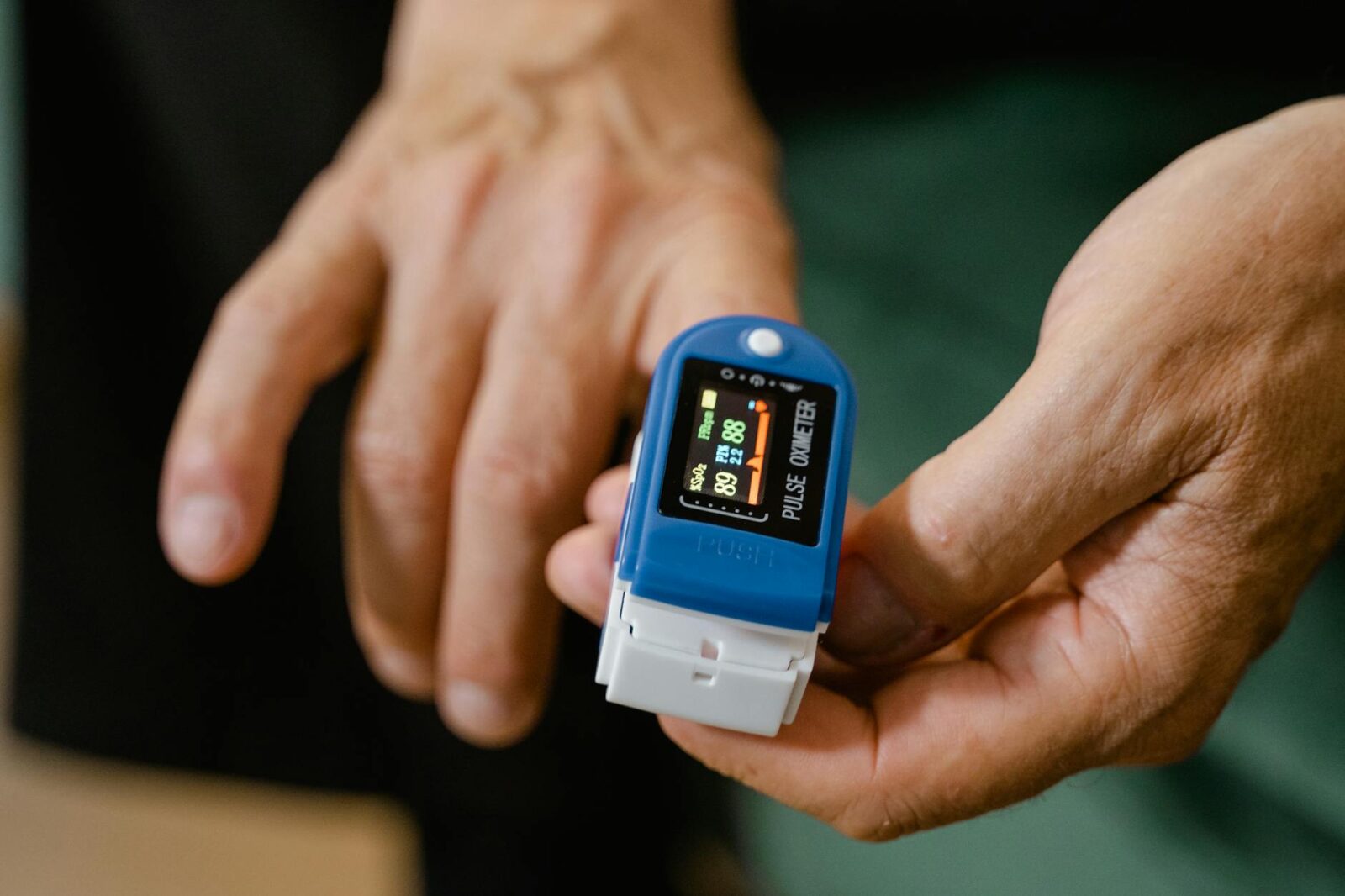Get yours here in Canada:https://amzn.to/3vXonYa
(We are an Amazon Affiliate)
The Ultimate Guide to Pulse Oximeters for Health and Fitness Enthusiasts
In an era where personal health tracking has become as common as checking the weather, there’s one gadget that’s gaining traction among a wider demographic than just the health-conscious. Enter the pulse oximeter, a tiny, portable device that measures the oxygen saturation level in your blood. Traditionally used in clinical settings, these fingertip-clipped monitors have now encroached into the spheres of outdoor sports and fitness regimes, becoming an essential tool for those who want to track their health and performance.
Unveiling the Power of Pulse Oximeters
Pulse oximetry is a non-invasive method for monitoring a patient’s oxygen saturation (SpO2) and heart rate. This tool employs the principle of spectrophotometry—shining light through blood vessels in the fingertip or earlobe—with average accuracy levels between 95% and 100%, making it a reliable home healthcare device.
Why You Might Need a Pulse Oximeter?
Pulse oximeters bring a multitude of applications, some of the most compelling being:
Post-Surgery and Sedation Monitoring
After surgical procedures, or during sedated treatments, doctors often use pulse oximeters to ensure that a patient is being adequately oxygenated.
Exercise and Activity Levels
Fitness enthusiasts, especially those training at higher altitudes, utilize oximeters to monitor oxygen levels during intense regiments, ensuring they are not pushing their body too hard.

Respiratory Health Checking
A key tool for those with respiratory conditions like COPD, asthma, and sleep apnea, pulse oximeters help in better management by alerting to drops in oxygen saturation.
The versatility of pulse oximeters isn’t just about health monitoring—it’s about enhancing the quality of life for those with conditions that affect blood oxygen levels, helping optimize fitness routines, and ensuring recovery post-surgery or treatment.
How Do Pulse Oximeters Work?
The operation behind a pulse oximeter might seem complex, but in practice, it’s quite simple. A pair of light-emitting diodes (LEDs), typically one red and one infrared, are positioned on one side of the clip. On the opposite side, a photodetector measures the amount of light that passes through the finger or earlobe. Since oxygenated and deoxygenated blood absorb light differently, the device can accurately determine the proportion of each in the bloodstream, thereby providing a reading of SpO2.
The Merits and Myths of Finger-Clip Health Tech
There’s a fair share of buzz—and a few fallacies—surrounding finger-clip health tech. While some critics dismiss these devices as unreliable, the reality is that advancements in sensor technology have greatly improved their accuracy. Current models boast calibration to high standards and are commonly used in parallel with traditional testing apparatus in healthcare settings.

Accuracy and Precision
The difference in accuracy between high-quality pulse oximeters and lab-grade equipment is often less than 2%. For most users, this margin is more than sufficient to gauge health trends or the effectiveness of lifestyle changes.
IN CANADA:https://amzn.to/3vXonYa
Portability and Convenience
Pulse oximeters are about the size of a matchbox, slightly heavier, and can easily fit in a pocket or sports bag. They require minimal setup and can be used on the go, making them a valuable asset in any environment.
Cost-Effectiveness
Investing in a pulse oximeter is a one-time purchase that can potentially save on regular clinic visits, particularly for individuals with chronic respiratory conditions or athletes needing constant monitoring during high-altitude or high-intensity training.
High-Octane Health Readings on the Go
For outdoor enthusiasts and athletes, the ability to monitor oxygen levels during workouts or climbs can make a world of difference.

Acclimatization to Altitudes
Altimeters aren’t the only gear to consider when trekking into high-altitude zones; pulse oximeters become the referee between your body and extreme elevations. Over time, users can observe and manage improvements in their body’s acclimatization.
Cardiovascular Performance
Maximizing cardiovascular performance is a key to success in many sports. Pulse oximeters provide real-time data to optimize training and help prevent overexertion.
Wilderness Medicine Companion
In remote locations, the readings from a pulse oximeter can serve as an early indicator of more serious medical conditions, such as high altitude sickness or other circulatory issues, prompting users to seek appropriate care quickly.
Health and Safety—The Handheld Way
For those not scaling mountains or training for marathons, a pulse oximeter still holds significant benefit. It’s a reassuring tool for maintaining a healthy lifestyle.

Supporting Chronic Conditions
Individuals with chronic health conditions like COPD, asthma, or heart disease can use pulse oximeters to monitor their oxygen levels on a regular basis, aiding in disease management.
Peace of Mind for Post-Recovery
After recovering from an illness, or for anyone experiencing shortness of breath or respiratory symptoms, regular monitoring can provide peace of mind, ensuring there are no unexpected drops in oxygen levels.
An Extra Tool in Your First Aid Kit
Together with a basic first aid kit, a pulse oximeter is a pertinent inclusion for emergency preparedness, equipping users with the ability to rapidly assess the severity of a medical situation.
Buying a Pulse Oximeter—What to Look For
When shopping for a pulse oximeter, several key features warrant consideration:
Accuracy and Precision
Look for devices with a high declared accuracy, which are often reflected in professional reviews and user feedback.
Ease of Use and Portability
A simple, one-button design is optimal, ensuring that you can get readings quickly without fuss.
Battery Life and Durability
Long-lasting batteries are vital for outdoor use. Devices that are water-resistant and shockproof can also be incredibly useful for adventurers.
Display and Data
An easy-to-read display, particularly in sunlight, and the ability to store and review historic data can be pivotal in tracking your health history.
Security and Support
Purchasing from reputable brands and vendors is critical. Also, ensure that the device comes with adequate after-sales support and a warranty.
The Pulse Oximeter Fit for Your Lifestyle
Finding the right pulse oximeter for you should align with your specific needs and lifestyle. Are you an urban jogger looking for high-intensity training insights, or a hiker who regularly tackles high-altitude terrene?

The Fitness Enthusiast’s Companion
For those invested in their workout regimes, a reliable device that can record and analyze data can be an invaluable training companion.
High-Altitude Trekker’s Toolkit
Durability against the elements, and the ability to function in cold and low-pressure conditions, are a must for the serious climber or hiker.
Well-Being for Everyday Use
An easy-to-use, durable, and affordable oximeter is ideal for everyday household purposes or for individuals monitoring a long-term health condition.
On the Radars of Future Health Tech
The growth of wearable health technology, now including pulse oximeters, continues to surge. With their increasing accuracy, reliability, and integration with smartphones and other health apps, these devices are poised to penetrate even deeper into the consumer market.
Data-Driven Health Goals
By syncing pulse oximeter data with health apps, users can maintain an insightful track of their health measures, thus setting and achieving realistic health goals.
Seamless Connectivity
The latest pulse oximeters are equipped with Bluetooth connectivity, which allows users to access their readings on the go, whether checking stats on their smartphones or updating a cloud-based health journal.
The Integration of AI
With the advent of artificial intelligence, pulse oximeters could potentially not just monitor but also interpret health trends, notifying users of potential issues or suggesting adjustments to their lifestyle.
A Word on Safety and Privacy
Just like any health monitoring device, it’s essential to be mindful of the data gathered and shared. Always deal with reputable sellers, secure your device from unauthorized access, and be cautious about sharing health data beyond trustworthy, secure platforms—privacy breaches in health tech are as real as with any other sensitive data.
Pulse Oximeters—A Final Verdict
While pulse oximeters are an excellent addition to any health or fitness enthusiast’s toolkit, they aren’t a substitute for professional medical advice. However, they undeniably offer users an empowering way to participate in their health management and are essential for serious athletes and adventurers. Whether it’s for personal peace of mind, a data-driven approach to fitness, or as a preventative health measure, the pulse oximeter is a valuable device that’s reshaping how we interact with our well-being—portable health tech at its best!
